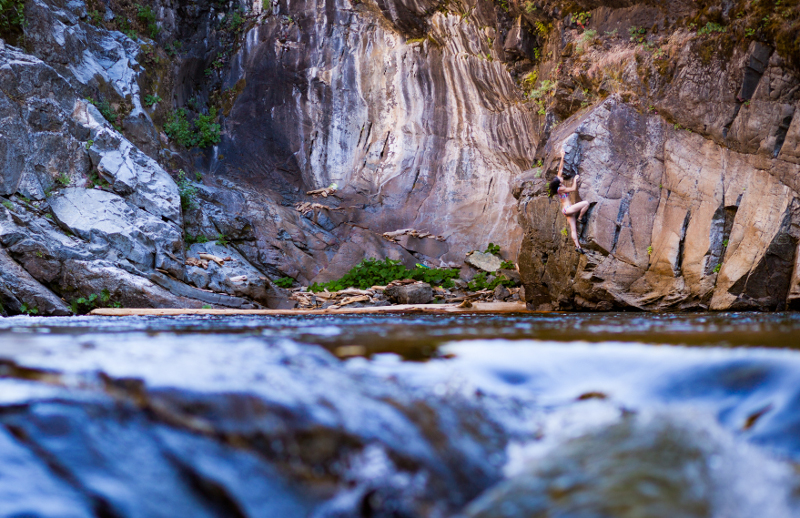Dean Fleming was born and raised in Sonora, CA, the gateway to Yosemite Valley. Once the youngest certified professional climbing guide in the country, he eventually combined his love of writing, photography, earth science, and rock climbing into a career of sharing his stoke and expertise through publishing. Dean is the author of the Columbia Bouldering Guidebook and the founder and editor of California Climber Magazine. In this series, he’ll be sharing a taste of some lesser-known, high-quality climbing areas in our favorite state, plus how to take care of these special places for years to come.
Words and images by Dean Fleming. A portion of this article was originally published in the Summer 2018 issue of CA Climber.
Clutching roots and gobs of dirt, we traversed a narrow poison oak covered ledge over the South Fork of the Tuolumne River. Below us the water raged through a steep canyon. It was later brought to our attention that this portion of the Tuolumne is widely regarded as the most difficult section of commercially guided whitewater in North America. Here, a seemingly immeasurable amount of water raged over 50-foot overhanging granite cliffs. Waterfalls pounded deafeningly into rapids, interrupted only by the occasional thundering sounds of 1,000lb logs tumbling down the riverbed. Like a child flicking a toothpick at their siblings, the river moved these huge trees with ease. Gazing down from our perch above the stream, it was hard to imagine that even the most insane person would ever have the gall to climb into a boat and shove off down these rapids. We turned our attention back to the task at hand, steadily making our way downstream toward smaller waterfalls, where the steep granite rocks loomed above calmer waters.
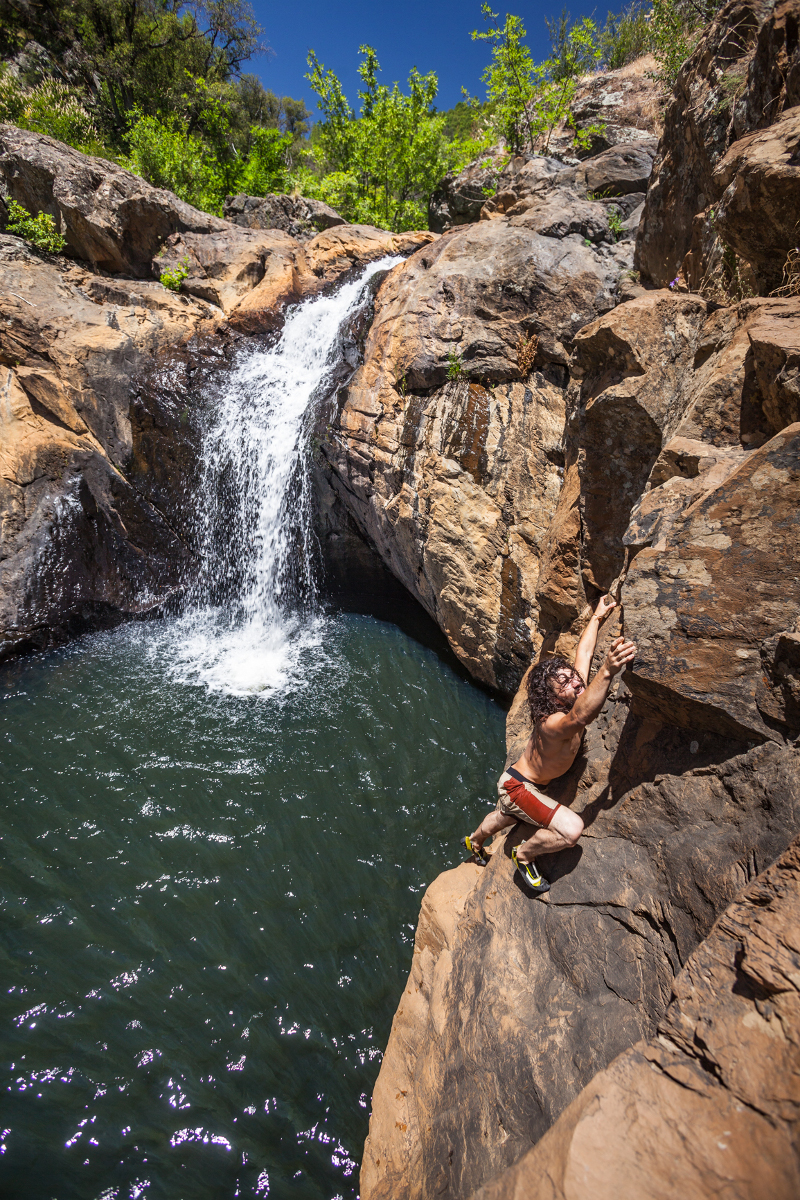
Sliding down polished slabs, jumping between jammed logs and river stones, we moved about a mile downstream from the popular swimming area Rainbow Pools—a place where guys named Chad with tattooed dad bods nearly outnumber the Mountain Dew cans that litter the banks. The steep cliffs adjacent to the waterfall at Rainbow do make for great deep water bouldering, and early on weekdays or in the off-season we’d managed to grab some good sessions there. But today, as we didn’t feel like fueling the hoots and hollers from the bros and tourists at the main pool, the mission was to venture downstream into a canyon that was rumored to have numerous steep cliffs adjacent to idyllic waterfalls and tranquil swimming holes.
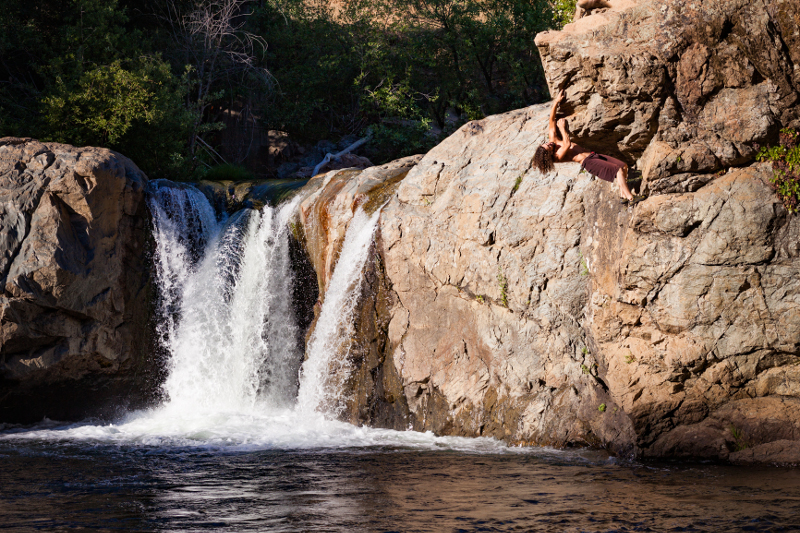
The idea to go climbing above the water here in California came to us about as naturally as an idea can: it’s hot and it’s dry, we want to go swimming and we want to go bouldering. Although the Psicobloc movement in Greece, Spain, Vietnam, and Thailand has certainly increased the popularity and awareness of deep water soloing, climbing ropeless above water is likely as old as climbing in the traditional sense—perhaps older.
The idea to go climbing above the water here in California came to us about as naturally as an idea can: it’s hot and it’s dry, we want to go swimming and we want to go bouldering.
Nevertheless, when one thinks about deep water soloing, California is hardly the first place that comes to mind. And it’s true that we don’t really have any famous deep water solos here—Creature from the Black Lagoon (5.10c) up in Tuolumne has become quite a novelty among local boulderers lately, but I doubt any Spaniards or Greeks would pack their swimsuits and extra chalk bags just to send it. If one actually decided to search every speck of the Golden State they would probably never find another Majorca, or anything even close to that. Still, where water flows through steep canyons and places with hard rock (which we do have a lot of) you’re likely to find something that is safely climbable, and some great swimming to go with it.
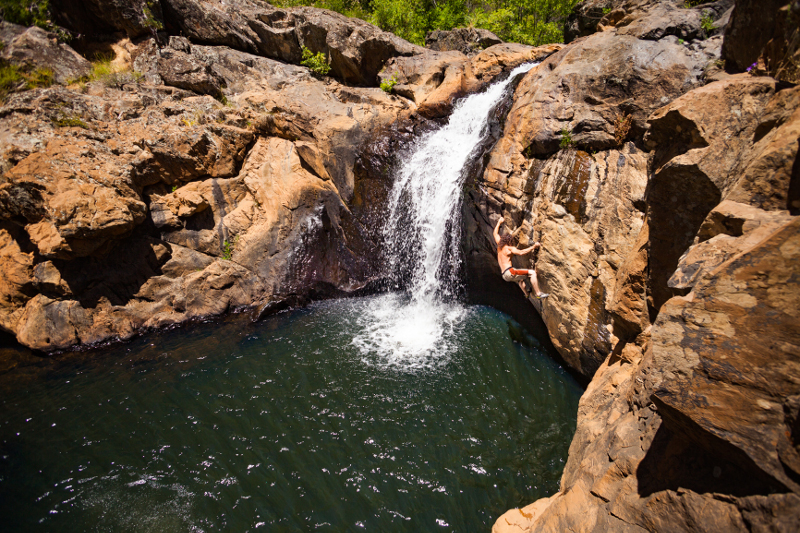
In the paragraphs that follow you’ll find just a small handful of California’s rivers—a few of which host some pretty incredible deep water bouldering and deep water soloing options. The rivers featured here are mostly spread throughout the Central Sierra near the granitic batholiths that have created so much of the excellent climbing that California is famous for. Here you’ll find smooth, Yosemite-like walls that produce splitter cracks, golden patina jugs, and incut crimps, but you’ll also find some pretty strange rock formations that lend themselves to steep pocket-pulling and gymnastic movement. Although you probably won’t find a limestone archway begging to be featured in the next Sender Films flick, you might have a great time playing around on the sun-soaked rocks, moving along cool holds and interesting features, until the time when your forearms are pumped and your climbing shoes are baking from the summer sun. It’s here that you’ll find a sweet sense of joy and reprieve as you plummet from the rocks into the cool water below.
It’s here that you’ll find a sweet sense of joy and reprieve as you plummet from the rocks into the cool water below.
The Tuolumne River flows for 149 miles from the high Sierra Nevada to join the San Joaquin River in the Central Valley. Originating at over 8,000 feet above sea level in Yosemite National Park, the Tuolumne drains a rugged watershed of 1,958 square miles, carving a series of canyons through the western slope of the Sierra. Just west of Yosemite National Park, The South Fork of the Tuolumne flows through one of the steepest canyons in the Sierra Nevada, passing through the incredible swimming hole Rainbow Pools, and then down the most difficult commercially rafted section of white water in North America to meet the Middle Fork Tuolumne. Here, and in the canyons below, excellent deep water soloing and bouldering can be found. Access to Rainbow Pools couldn’t be easier, but the waters below are quite difficult to navigate. Additionally, fast moving water and pounding waterfalls can create some seriously dangerous swimming conditions.
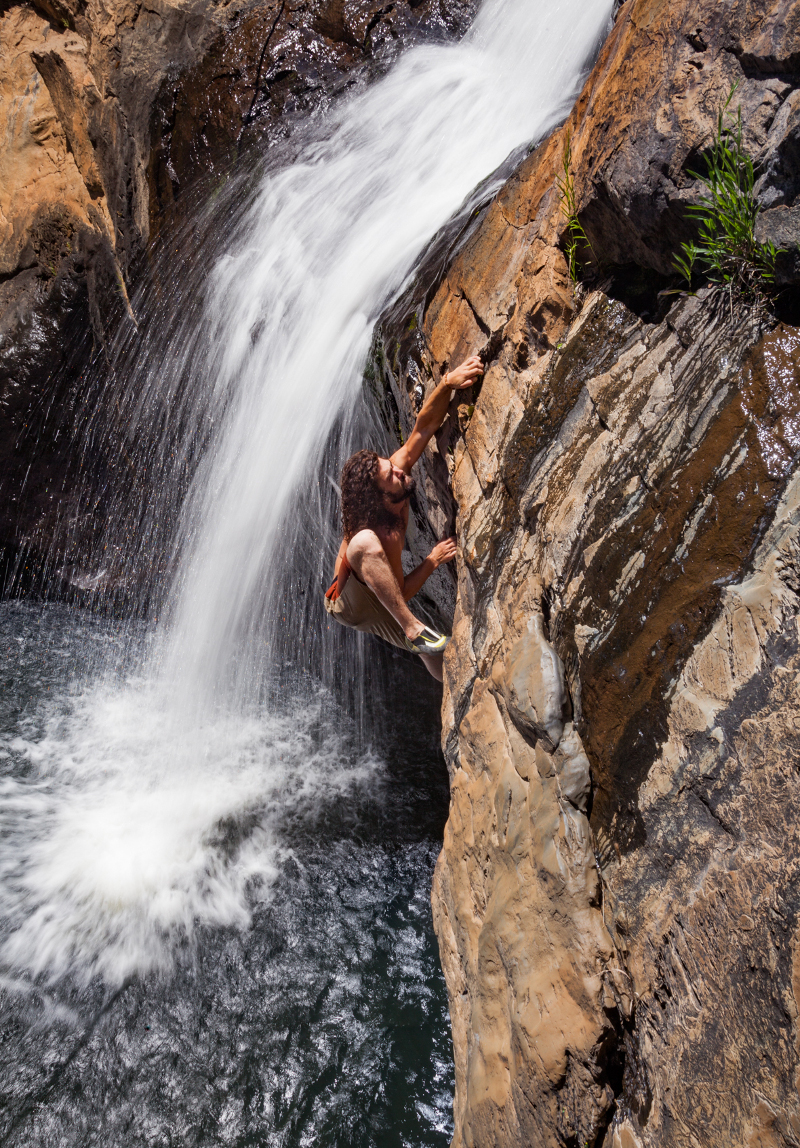
Special Concerns:
California’s riparian ecosystems are among the most fragile in the region, so please do your best to minimize your impacts at all of these areas. As with an unfortunate number of swimming holes in the Central Sierra, a few of these zones might be trashed from high school-aged hooligans. Instead of adding to the unsightly mess, it would be awesome to pack in a trash bag or two to set an example for the youngsters. If you’re a youngster yourself and you decide to pack out a few abandoned Rockstar cans on your way out, well, more power to you!
New Routes:
It is a somewhat unspoken rule while climbing above water, that if a climb is mossy or chossy or excessively dirty, it’s really not worth rappelling down it and then knocking down gallons of debris and soil into the riverbed just so we can scramble up it. If you feel like you need to “develop” a climb above the river, then it’s probably best to just walk a few yards downstream to find something better.
